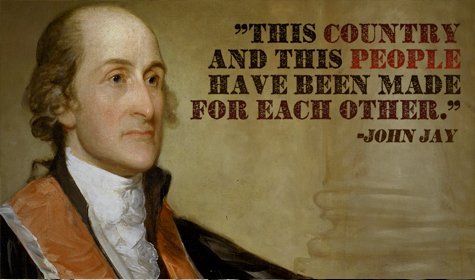EDITOR’S NOTE: The following is the second in a series of articles giving an introduction to the Federalist Papers, a collection of 85 articles and essays written by Alexander Hamilton, James Madison, and John Jay promoting the ratification of the United States Constitution. To read the first federalist article go HERE.
After outlining the reasons for defending ratification of the Constitution, and characterizing his opponents as essentially unreasonable and extreme in Federalist #1, Alexander Hamilton hands off the quill pen to John Jay for Federalist #2.
Today, Jay is probably least known of the three Federalist Papers authors, but he was extremely influential in New York during the ratification period. Jay was a member of the First Continental Congress, drafted the New York state Constitution in 1777, and served as the state’s first chief justice. New Yorkers elected him to the Continental Congress again in 1778, and he served as the body’s president.
Since the Federalist was principally directed at New Yorkers, Jay’s contribution certainly carried considerable weight.
In Federalist #2, Jay contends the continuation of the Union depends on ratification, and addresses those supposedly advocating for a division of America into separate confederacies.
“It has until lately been a received and uncontradicted opinion that the prosperity of the people of America depended on their continuing firmly united…But politicians now appear, who insist that this opinion is erroneous, and that instead of looking for safety and happiness in union, we ought to seek it in a division of the States into distinct confederacies or sovereignties.”
In fact, breaking up America into confederacies was an extreme position, even among opponents of the Constitution. Historian Herbert J. Storing argues that the Federalists basically manufactured and propagated the idea that Anti-Federalists wanted to break up the Union, knowing it was an extremely unpopular position.
“While Patrick Henry and some other Anti-Federalists were widely thought to favor separate confederacies, their public statements describe dissolution of the Union only as the lesser of evils.
“The Federalists ‘generated’ much of the talk about separate confederacies in 1787-1788 because they thought it was the end to which the Anti-Federalist opposition to the Constitution was, more or less deliberately, pointing. The Anti-Federalists’ frequent denial of the capacity of any republican government to extend over such wide territory as the United States left them open to the criticism of striking at the root of the union itself.”(1)
Jay challenges this position head-on, arguing that America should “to all general purposes, be one nation, under one federal government.”
He first points out that the geography of America lends itself to one Union, noting that “independent America was not composed of detached and distant territories, but that one connected, fertile, widespreading country.”
He then characterizes Americans as “one united people.”
“A people descended from the same ancestors, speaking the same language, professing the same religion, attached to the same principles of government, very similar in their manners and customs, and who, by their joint counsels, arms, and efforts, fighting side by side throughout a long and bloody war, have nobly established general liberty and independence.”
Jay used brilliant rhetorical strategy. Most readers would have likely nodded in agreement at Jay’s assessment, and by establishing America was already an organic union directed by “Providence,” it logically followed that the country should remain politically united.
“This country and this people seem to have been made for each other, and it appears as if it was the design of Providence, that an inheritance so proper and convenient for a band of brethren, united to each other by the strongest ties, should never be split into a number of unsocial, jealous, and alien sovereignties.”
Midway through Federalist #2, Jay abruptly shifts gears, launching into a defense of the Constitution’s drafters. He once again appeals to popular sentiment, analogizing the framing of the Constitution with the process that ultimately led to American independence.
“But if the people at large had reason to confide in the men of that Congress [that led the country to independence], few of whom had been fully tried or generally known, still greater reason have they now to respect the judgment and advice of the [Philadelphia] convention, for it is well known that some of the most distinguished members of that Congress, who have been since tried and justly approved for patriotism and abilities, and who have grown old in acquiring political information, were also members of this convention, and carried into it their accumulated knowledge and experience.”
Jay then circles back to his main point – reminding Americans they want and need to remain united, and rejection of the Constitution would “put the continuance of the Union in the utmost jeopardy.”
“It is worthy of remark that not only the first, but every succeeding Congress, as well as the late convention, have invariably joined with the people in thinking that the prosperity of America depended on its Union.”
Jay ends Federalist #2 with a dire warning.
“…whenever the dissolution of the Union arrives, America will have reason to exclaim, in the words of the poet: ‘FAREWELL! A LONG FAREWELL TO ALL MY GREATNESS.’”
1. Storing, Herbert J., and Murray Dry. What the Anti-Federalists Were for. Chicago: U of Chicago, 1981, pg. 87

